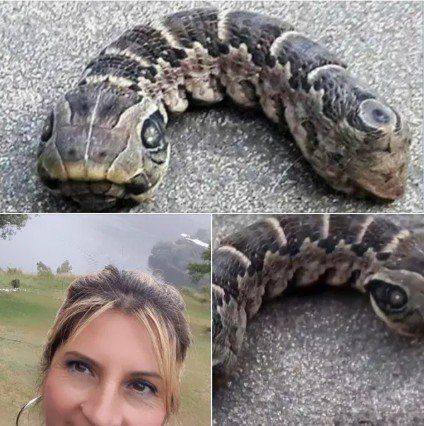In the realm of unusual creatures, the two-headed snake is one of the most captivating and perplexing phenomena. The concept of a snake with two heads may seem like something straight out of a fantasy novel or an ancient myth, but in reality, these creatures do exist. Whether you have seen viral videos or heard of them through friends, two-headed snakes have fascinated and intrigued people for centuries. However, despite their captivating appearance, these unique snakes carry a great deal of mystery, and there is more to them than meets the eye.

A Misunderstood Phenomenon: What’s Really Happening?
A two-headed snake is a rare occurrence, with most instances stemming from a condition known as bicephaly. Bicephaly occurs when an embryo that was originally destined to become a single individual snake instead divides into two incomplete, conjoined embryos. The result? A snake that possesses two heads, each capable of independent movement. Though incredibly rare, bicephaly has been documented in various species, from reptiles to other vertebrates.
When first discovering a two-headed snake, the immediate response is often one of awe or amazement. People are quick to label these creatures as “mutations” or “monsters,” but in truth, they are simply examples of a fascinating natural anomaly. Two-headed snakes do not represent some supernatural force, but rather the result of a developmental error during the early stages of life.
A Tale of Survival: How Do Two-Headed Snakes Function?
The unique anatomy of a two-headed snake brings with it a set of challenges that can make survival difficult. Although both heads are functional and capable of independent movement, coordination between the two can be problematic. For instance, if each head is trying to control the snake’s movement independently, they might pull in different directions, causing the snake to become disoriented or even immobilized.
The two heads often have separate brains, and as such, they might sometimes behave as if they have their own personalities and desires. One head might attempt to strike at prey, while the other might not be in agreement. Such behaviors can be detrimental to the snake’s survival in the wild, where quick and coordinated actions are essential for hunting and evading predators.
While most two-headed snakes live in captivity where they are well-cared for and can be protected from predators, those found in the wild often face a much harsher reality. Their inability to function efficiently as a single entity makes them vulnerable to danger, and survival becomes a constant battle. However, there have been instances where two-headed snakes have been able to thrive, but these cases are exceptional and require special conditions.
Famous Two-Headed Snake Cases
Over the years, several two-headed snakes have gained attention for their bizarre and unique characteristics. Some have been brought into the scientific community for study, while others have simply been the subject of fascination for the public. One notable example is the Bicephalic Rat Snake that was discovered in Florida. This snake quickly gained viral popularity after it was captured on film and shared across social media.
In 2009, a two-headed Eastern Kingsnake was found in a pet shop in the U.S. The snake was dubbed “The Kingsnake” and was put on display for public viewing, where it became an instant sensation. The snake, however, had its fair share of difficulties. The two heads, although fully functional, would often fight for control over the snake’s body, making it challenging for the animal to move and eat. The shop decided to euthanize the snake due to its poor health and inability to survive independently.
In the wild, it’s incredibly rare to come across a two-headed snake due to their vulnerability to predators and their inability to hunt or escape effectively. These snakes often die young, but there are a few documented cases where two-headed snakes have survived longer than expected. For example, a two-headed garter snake was discovered in Minnesota and managed to survive in the wild for several years, although it struggled with the same survival issues that plague other bicephalic creatures.
Myths and Superstitions: The Snake with Two Heads in Ancient Cultures
The two-headed snake has captured the human imagination for centuries, often being associated with supernatural or divine qualities. In various cultures, serpents and snakes are seen as symbols of power, knowledge, and even rebirth. In ancient Greek mythology, the Hydra, a serpent-like creature, was said to have multiple heads that could regenerate when cut off. The creature was eventually slain by Hercules, making it one of the most famous mythological snakes with multiple heads.
Similarly, in Hinduism, the Naga, a multi-headed serpent, is considered to be a deity of water, fertility, and protection. The Naga is often depicted with multiple heads, and its image has been used in religious art and architecture for centuries. The two-headed snake, therefore, holds great symbolic weight in many cultures and continues to captivate the imagination of those who hear its myth.
In modern times, the discovery of a real two-headed snake often brings these ancient myths and legends to mind. Many people are quick to connect these animals to mystical or supernatural forces, but in reality, they are simply rare occurrences that result from an unusual biological process.
The Science Behind the Two-Headed Snake: How Does Bicephaly Happen?
From a scientific perspective, two-headed snakes are fascinating subjects for study, as they offer valuable insights into the complexities of development and genetics. Bicephaly, the condition that causes the formation of two heads, occurs when the fertilized egg splits into two embryos but fails to separate completely. Instead of forming two separate snakes, the embryos remain conjoined, resulting in a snake with two heads.
This condition can occur in various species, though it is far more common in reptiles than in other animals. The process is thought to be the result of genetic mutations or environmental factors that influence development. It is important to note that bicephaly is not hereditary, meaning that it is not passed down through generations. Instead, it happens as a random occurrence during the development of the embryo.
The two heads of a bicephalic snake each have their own nervous system and brain, which makes them highly independent in terms of decision-making and movement. However, the coordination between the two heads is often not perfect, and the snake can struggle to function as a unified whole. In rare cases, the heads can even fight for control over the body, leading to difficulties in movement, feeding, and overall survival.
Conservation and Ethical Concerns: The Fate of Two-Headed Snakes
While some two-headed snakes live in captivity and are kept in research facilities or zoos, others have been bred specifically for the exotic pet trade. However, ethical concerns arise in these cases. Because two-headed snakes often suffer from coordination issues, they can live short and painful lives in captivity. The lack of full cooperation between the two heads can also result in injuries, as one head might attempt to strike prey while the other does not, causing internal damage.
Conservationists argue that two-headed snakes should be kept in natural habitats whenever possible, and efforts should be made to protect these rare creatures. The issue, however, is that many two-headed snakes found in the wild are often unable to survive long enough to contribute to the gene pool. As a result, their numbers remain exceedingly small.
Conclusion: The Wonders of Nature
The two-headed snake is a rare and fascinating anomaly that serves as a reminder of the complex beauty of nature. While these creatures may seem strange or unsettling, they are simply a product of the marvels of biological development. The stories and discoveries surrounding these snakes continue to captivate people around the world, inspiring scientific inquiry and sparking cultural fascination.
From a scientific standpoint, these creatures are a window into the mysteries of genetics, development, and evolution. While their life expectancy may be short, the legacy of these two-headed snakes will live on in the research that continues to unfold. Ultimately, the two-headed snake reminds us that nature is full of surprises, some of which are both mystifying and deeply inspiring.

